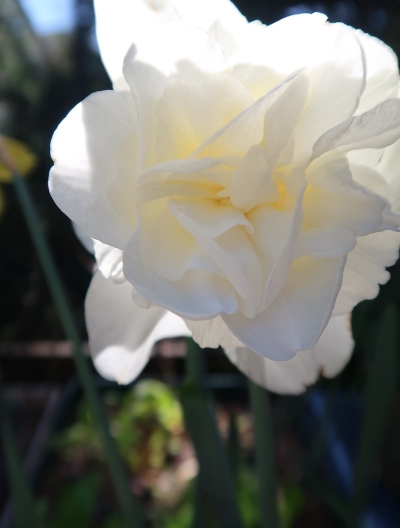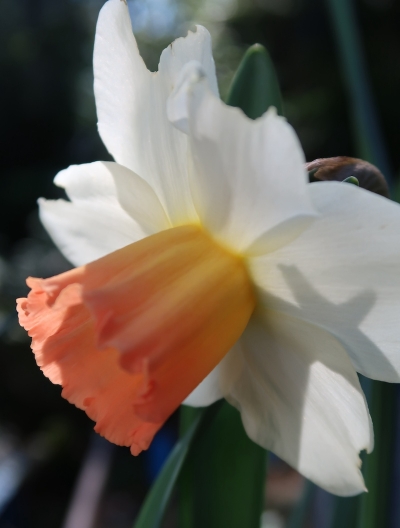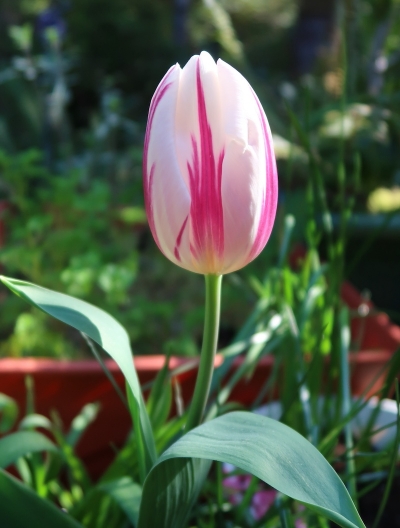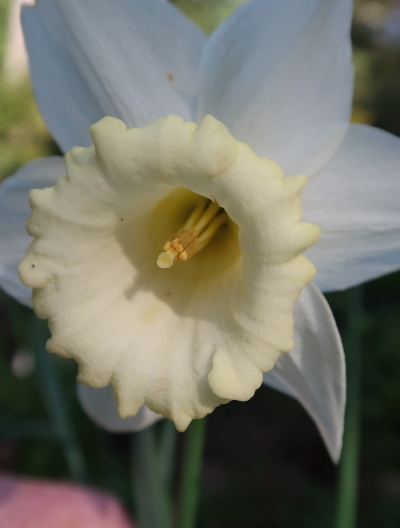Greetings and a Happy April Fool's Day!
After 11" of rain in March and snow the end of February, spring seems to have sprung around here, too! The photos at the bottom of this newsletter were taken on our deck. A few of the flowers are a little beat up from the wind, but they are still promising sunnier and warmer days ahead! I hope you will enjoy the April issue of Pianotes!
The piano was "invented" in about 1709, by Bartolomeo Cristofori, who was a harpsichord builder. Harpsichords and clavichords were the keyboard instruments of the day, but they were very quiet instruments and no matter how much force the player used on the keys, the volume never changed. If you've ever listened to harpsichord music for a long period of time, you know that although the music may be quite beautiful, the sound can become monotonous. There was a movement in the late 1600s and early 1700s to put a great deal of emotion into the creative arts, so Cristofori set out to find a way to put more expression into keyboard playing. How do you put expression into music? Usually by changing your speed and volume. Harpsichords have a mechanism that plucks the strings when the keys are pressed, so there is no way to change the volume when they are played. Cristofori found that by having hammers hit the strings, the amount of pressure that the fingers put on the keys changed the volume of sound that came out of the instrument. He called his invention a "pianoforte," which means "soft and loud."
In addition to “inventing” the piano, Bartolomeo Cristofori invented the "una corda" pedal (the soft pedal) in about 1726.
The damper pedal is often referred to as the "loud" pedal, but it does not change the volume of sound that comes out of the piano. It only sounds louder when the player holds it down too long and all of the strings are vibrating at once!
New Reviews: We have another international assortment of reviews for you this month! Reviewed albums and singles came from Spain, Canada and Germany as well as from the US. I also reviewed Jim Wilson's fantastic new book,
Tuned In: Memoirs of a Piano Man, which will be released on April 2, 2024, and sheet music/songbooks from Ralph Zurmühle, Jim Wilson (2) and Eric Chapelle, so there is a lot of new material for you to check out! You can find
links to all of them here.
The first modern pedal mechanism was developed by piano builder Sebastien Erard in 1810.
Steel piano strings and felt-covered hammers were introduced in 1826 by Jean-Henri Pape.
In 1930, Koichi Kawai left his job at Yamaha to start his own piano-building company.
New Interviews: I did a new interview with
Jim Wilson to talk about his new book as well as his life. I'm currently working on an interview with Alejandro Clavijo and hope to have a link for you before I publish this newsletter. If not, check back because it should be ready in the next couple of days and will have a link on the
MainlyPiano homepage.
An architect built an apartment building in New York in 1891 that had an upright piano built into every parlor.
In 1866, a piano was patented that turned into a couch and had closets for bed clothes and a wash basin. The stool converted to a workbox, looking glass, desk, and a small set of drawers.
Vladimir de Pachmann, a piano virtuoso of the late 19th and early 20th centuries, claimed that milking cows was the best finger exercise there was.
April Birthdays: Here are some of the musical birthdays coming up this month:
4/4: Andy Mitran, Loren Evarts
4/5: Frank Horvat
4/9: Jim Chappell
4/11: Roth Herrlinger & Isabelle De Ferrari
4/13: Stacey Bonk
4/14: Milana Zilnik, Alejandro & David Clavijo
4/15: Anastasia
4/16: Josie Quick & Sean Michael Paddison
4/21: RJ Lannan
4/22: Stephanie Sante
4/23: Michael Brant DeMaria & David Pena
4/24: Carol Nicodemi
4/25: Faith Angelina
4/26: Scott D. Davis
4/28: John Nilsen & Carolyn Southworth
Happy Birthday to all of you!
The first classical record to sell 1 million copies was a performance of Tchaikovsky's Piano Concerto #1 by Van Cliburn, recorded in 1958.
Piano tuning was a special skill after 1750, and became an occupation in the 1800's.
According to a newspaper estimate in 1791, about twenty-seven Boston families owned pianos. All of the instruments were made in London.
April Music Holidays and Observances:
All Month: International Guitar Month, Jazz Appreciation Month
Weeks: 7-13:International Trombone Week
National Dance Week 19-28
National Karaoke Week 21-27
1 - National Trombone Players Day
3 - National Film Score Day, Fan Dance Day
6 - Waltzing Matilda Day
11 - Barbershop Quartet Day, International Louie Louie Day
16 - World Voice Day
20 - Record Store Day
24 - New Kids On the Block Day
27 - International Dance Day
30 - International Jazz Day
Jonas Chickering began as a cabinetmaker in Ipswich, New Hampshire. In 1818, at the age of 20, he sought his fortune in Boston by becoming an apprentice in one of the town's few piano-making shops. Three years later, he was in the piano-making business with a partner. He later went on to be one of the most successful piano-builders in America.
At Dolly Madison’s request, a piano was purchased specifically for the White House, but it was destroyed when the British burned the building during the War of 1812.
Steinway presented the White House with an ornate gold-covered grand piano during Theodore Roosevelt’s administration. It was the 100,000th piano built by the company, and now stands in the Smithsonian Institution.
I think that's all of the news for this month! Have a great April, and we'll see you back here around May Day! Enjoy the photos below!
Kathy
A recording of a Bach prelude played by pianist Glenn Gould was placed onboard the Explorer mission to prove the existence of intelligent life on earth.
Early upright pianos were called “giraffes” and were about 7 1/2’ tall!
In 1868, Paris, France had about 20,000 people involved in teaching piano.
To the best of my knowledge, the "trivia" items are true, but I can't guarantee it.










